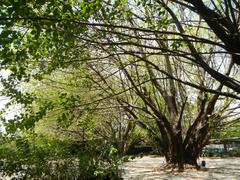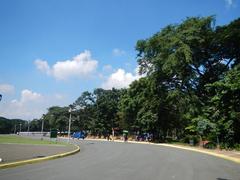Jorge B. Vargas Museum And Filipiniana Research Center
University of the Philippines Diliman Visiting Hours, Tickets, and Historical Sites
Date: 01/08/2024
Introduction
The University of the Philippines Diliman (UPD) is a prominent institution known for its academic excellence and cultural heritage. Located in Quezon City, it stands as a pivotal center for education, research, and public service in the Philippines. Established in 1908, the university has a rich history that reflects the nation’s journey towards academic and cultural development. Initially located in Manila, the university moved to its current site in Diliman in 1949, following a plan commissioned by President Manuel L. Quezon. The campus, designed by notable architects and planners, has since evolved into a blend of historical and modern structures set in a picturesque landscape (Filipiknow).
UP Diliman is not only an academic institution but also a symbol of the Philippines’ commitment to education and public service. Its significant events, such as the Diliman Commune of 1971, highlight its role in the nation’s socio-political landscape. The university’s extensive library resources, international alliances, and diverse academic programs further underscore its status as a premier institution (UPD History). Visitors to UPD can explore its beautiful campus, engage with its vibrant culture, and witness its contributions to various fields. Whether you are a prospective student, a history enthusiast, or simply a curious traveler, UP Diliman offers a unique and enriching experience.
Table of Contents
- Introduction
- Establishment and Early Years
- Academic Excellence and Research
- Architectural Evolution
- Cultural Significance
- Visitor Information
- Conclusion
Establishment and Early Years
The University of the Philippines (UP) was established on June 18, 1908, through Act No. 1870 of the Philippine Assembly. The institution was designed to provide advanced instruction in literature, philosophy, the sciences, and arts, and to offer professional and technical training to qualified students regardless of age, sex, nationality, religious belief, and political affiliation (Filipiknow). Initially, the university was located in Manila, but plans for a larger campus were already being considered as early as 1925.
The Move to Diliman
By 1939, the transfer of the university to a larger campus became part of a broader project to relocate the capital to a new city. President Manuel L. Quezon commissioned a team of experts, including Filipino architect Juan Arellano, American planner Harry Frost, landscape architect Louis Croft, and engineer AD Williams, to design the new campus. Although the master plan and the first two buildings were completed before World War II, the university had to wait until the war ended to relocate. Between December 1948 and January 1949, under the leadership of UP President Bienvenido Gonzales, the university gradually moved from Manila to the larger campus in Diliman. The iconic Oblation statue was moved on February 11, 1949 (Filipiknow).
Growth and Development
UP Diliman (UPD) was formally established as an autonomous unit at the 976th meeting of the Board of Regents (BOR) on April 23, 1985. Today, it is the largest constituent university in terms of the number of degree-granting academic units, student population, faculty, and library resources (UPD History). The campus occupies 493 hectares of prime land in Quezon City and offers a comprehensive array of disciplines at both the baccalaureate and post-baccalaureate levels. As of 2013, UPD had 27 degree-granting units offering academic programs in 376 major fields, with 72 programs at the doctoral level, 164 at the master’s level, and 140 at the undergraduate level (UPD History).
The Diliman Commune
One of the most significant events in UPD’s history is the Diliman Commune, which took place from February 1 to February 9, 1971. Inspired by the 1871 Paris Commune and the 1872 Cavite Mutiny, the Diliman Commune was a nine-day student protest against the Marcos government. Students, professors, and staff barricaded the roads in support of transport workers protesting an oil price hike. The protest ended on February 10, 1971, with the issuance of several demands, including the prohibition of military presence on campus. A marker commemorating the 25th anniversary of the Diliman Commune was installed along University Avenue in 1996 (Filipiknow).
Academic Excellence and Research
UPD is recognized as a model of undergraduate instruction, a center for graduate education and research, and a major source of leadership and expertise for public service. The university offers 275 academic programs, including 70 undergraduate programs, 105 master’s programs, and 48 doctoral programs. Additionally, UPD has seven Associate in Arts programs and 24 graduate diploma programs. The university also has extension programs in Pampanga and Olongapo City and specialized programs at the UP Professional Schools at Bonifacio Global City (UPD About).
Library Resources
The library resources of UPD are the largest in the country. As of June 2014, the collection included 1,170,723 volumes of books, pamphlets, bound periodicals, theses, dissertations, microforms, and various multimedia titles. The serial collection totaled 60,450, divided into 26,679 print titles and 33,771 unique titles in online journals. This collection has steadily grown through acquisitions and generous donations (UPD History).
International Alliances
UPD has extensive alliances with international institutions of higher learning for joint academic programs, research, and student exchange. As of March 2013, UPD had academic partnerships with 192 universities in Asia, Europe, North America, and Africa. These alliances provide opportunities for curricular enhancement, faculty development, resource generation, and sharing of expertise and programs (UPD History).
Architectural Evolution
The campus of UPD is a blend of old and new buildings set in a landscaped environment. This architectural evolution reflects changing theories and styles, as well as the university’s dynamic relationship with national concerns and events. The campus features a mix of academic, administrative, research, and residential buildings, as well as open spaces and wooded areas. The largest of these is the UP Arboretum, located at the northwest corner of the campus (UPD About).
Cultural Significance
UPD has played a crucial role in shaping Filipino leaders, national artists, scientists, and other trailblazers who have significantly influenced the country’s history. The university’s reputation for excellence is more than 100 years in the making, and it continues to be a vital institution for higher learning and public service in the Philippines (Filipiknow).
Visitor Information
Visitors to UPD can explore the campus without needing permits, except when arriving in large numbers, by chartered bus, or with large cameras. The main access to the campus is through University Avenue, coming from the Quezon Memorial Circle. Pedestrians can enter through any gate, while vehicles without a UP sticker must use University Avenue for entry and exit. UPD is open to visitors daily from 5 AM to 10 PM (Birdwatch).
Birdwatching
The UPD campus is one of the most popular places for birdwatching in Metro Manila. The campus offers a variety of environments where different types of birds can be spotted. The Academic Oval, the Science Complex, and the UP Arboretum are some of the best places for birding. As of now, 96 species of birds have been recorded on the campus (Birdwatch).
Nearby Attractions
While visiting UPD, consider exploring nearby attractions such as the Quezon Memorial Circle, the National Science Complex, and the Vargas Museum. These sites offer additional cultural and educational experiences within the vicinity.
FAQ
Q: What are the visiting hours for UP Diliman? A: UP Diliman is open daily from 5 AM to 10 PM.
Q: Are there any entrance fees to visit UP Diliman? A: No, there are no entrance fees to visit the campus.
Q: Can I bring a large camera or a chartered bus to the campus? A: Permits are required for large cameras and chartered buses. Please contact the campus administration for more details.
Q: What are some nearby attractions to visit while at UP Diliman? A: Nearby attractions include the Quezon Memorial Circle, the National Science Complex, and the Vargas Museum.
Conclusion
The University of the Philippines Diliman is not just an academic institution but a historical and cultural landmark. Its rich history, academic excellence, and significant contributions to the nation make it a must-visit destination for anyone interested in understanding the Philippines’ educational and cultural heritage. Plan your visit today and explore the many facets of this esteemed university.




